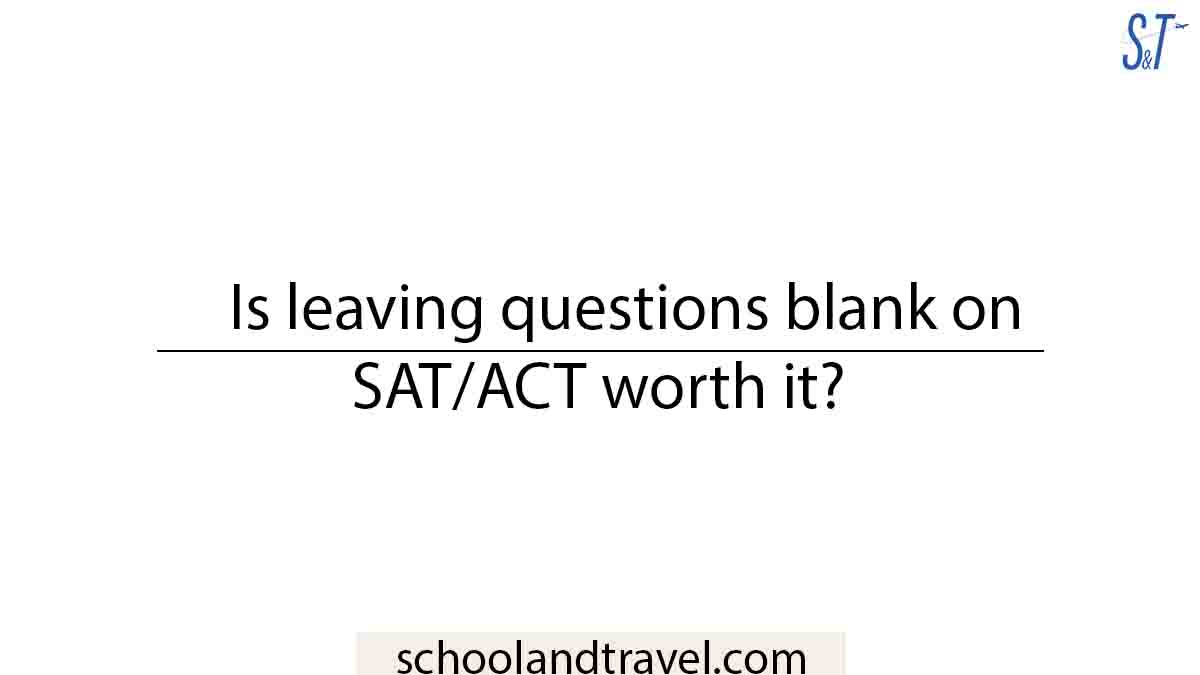Do you plan on leaving questions blank on SAT? Well, many students want to know how they will be graded before taking the SAT or ACT. They ask questions like:
- What is the score of each section?
- Is there an SAT/ACT curve like that?
- I don’t have an answer to a question. What should I do?
Taking knowledgeable guesses may be rewarded even though the SAT doesn’t penalize you for not answering all of the questions.
This article will provide answers to these questions above and help you understand how to handle questions in SAT/ACT.
What does SAT stand for?
SAT is an acronym that stands for Standardized Aptitude Test. It is an exam students take to get admitted into a college (especially in the United States and Canada) once they are done with High School education.
The College Board is in charge of the test, which is usually written by hand. People who want to go to college now have to take this exam. Moreover, it has been around for a long time.
You will be tested on your writing skills, math skills, which include doing math calculations, and your ability to critically read and analyze an essay. These skills will be tested during the exam.
The exam usually lasts about 3 hours, and 50 minutes when you write the optional essay part, which can be done at any time. One must get about 1060 points to be able to go to college.
Almost 2 million high school graduates take this exam every year. It’s available in every country and is taken 6 to 7 times a year by high school graduates.
What does ACT stand for?
People call the ACT the “American College Test” because the acronym has taken over what it stands for. ACT doesn’t have a specific name.
In the United States, most schools accept the ACT test. It is an international test that most schools accept. High ACT scores give you more power and a wider range of schools that you can go to.
Read more: ACT Prep Games (Meaning, Characteristics, Developers, ACT tips)
How Is the SAT Scored?
The SAT is graded on a 1600-point scale, with two components (Math and Evidence-Based Reading and Writing) ranging from 200 to 800. In addition, there is an optional essay that is graded independently.
Because there is no penalty for incorrect responses, your raw score is the total number of questions you properly answer.
Can I guess on SAT?
There has long been a guessing penalty on the SAT exam, under which students lost a quarter of a point for each incorrect response, and no points were awarded for answers left blank.
Many students avoided guessing on the SAT because they were afraid of receiving a lower score if their responses were incorrect. The SAT guessing penalty was abolished by the College Board in 2016.
Check out: SAT Cheats (SAT Meaning, Common cheats, Major Cheats, Measures)
Leaving questions blank on SAT? Step by Step
Step 1: Ignore it for the first time:
Skip questions that are causing you too much difficulty. Continue answering the questions until you’ve answered them all.
You won’t be stumped by any of the questions. If you’re confident in your answers, you’ll have ample time to complete the section.
Step 2: Give it a swing again:
That last question on the SAT or ACT is where you’ll go back to those unanswered ones once you’ve finished that section.
This is a tough one, so you’ll want to spend some time going over it before you begin. If you approach the problem from a different angle, you might even discover that you already know the answer.
Step 3: No Penalty for Giving the Wrong Answers:
Instead of leaving questions blank on SAT/ACT, you’ll be relieved to discover that on the ACT or SAT, incorrect responses will not be taken into account.
For every correct response, students will receive a point, and no points will be deducted for any erroneous ones.
This is why it’s so vital to never leave a question unanswered on a test. Try to answer the question and see what happens. I guarantee that if you leave this field blank, you’ll get it wrong.
Check out: How long does the SAT take and time management tips
What is SAT/ACT Curve?
There is no SAT curve, despite what you may have heard, contrary to popular belief. SAT scores will not be affected by how other test-takers do on the exam.
In other words, even if everyone else who took the SAT did poorly, the College Board wouldn’t enhance anyone’s SAT score to make up for the excess of low test results.
How To Guess on the SAT:
Elimination Method:
Instead of leaving questions blank on SAT/ACT, elimination is your best friend. For arithmetic problems, be on the lookout for any obvious outliers. There is a chance that these values are either too high or too low.
See what’s left when you cross them out. One answer can raise your odds of getting the correct answer from 25% to 33% if you eliminate just one of the possibilities.
Work backwards:
Working backwards from the answers you already have is an option when faced with formulas you’re not confident of.
Use caution while using this way of checking your work if you have a little extra time on your hands. Remember that the SAT also tests your ability to manage your time.
Look at pictures and graphs:
If a learner is too preoccupied with possible answers, diagrams and images can provide important hints. One or two solutions may be the most logical as a result of using this method.
Even more importantly, don’t just go with the first option that comes to mind. If you read a solution to a question that is intended to be of medium or higher level, it’s definitely a mistake.
Read more: 7 Easy Steps to Negotiate College Tuition
Frequently Asked Questions on leaving questions blank on SAT/ACT:
Yes, you can elimination method to get the answers in SAT/ACT
No, SAT doesn’t.
The argument that ACT response options are not completely randomized supports the notion that C is the best answer to choose when guessing an answer on a multiple-choice test. The implication is that answer choice C is the most frequently selected one.
Letter of the Day (LOTD): When you haven’t had enough time to work on a part, this is the best way to finish. Statistics say that you should pick one letter, like A, to start with. Because the SAT answer sheet is made by a computer, this means that the computer makes the answer sheet.
Conclusion:
Academic ability and college preparation are the primary goals of the SAT. Undergraduate applications from all over the country are compared using SAT scores by admissions committees.
There are several things you may do to prepare for the SAT, but the most important thing is to keep up with your studies.
Awesome one; I hope this article answered your question.
Share this Information.
Editor’s Recommendations:
- 11+ Universities to Study Abroad with WAEC or NECO
- How to study in Australia for free (Top Scholarships, Challenges)
- Hardest Bar Exams (Meaning, California Bar Exam, Study tips, Pass rate)
- Missouri Bar Exam (Meaning, Benefits, Study tips, Missouri tips)
- Internal Medicine Shelf (Meaning, Key Guides, Study tips)
- How Hard is the PCAT? (Meaning, Difficulty, How to study, Exam tips)




